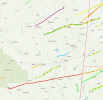Hurricane Melissa currently has wind gusts exceeding 215 mph. Praying for everyone currently in the path. It's going to be devestating.
If it makes landfall at this strength who thinks the wind damage will resemble an EF5 tornado? Will entire forests be flattened and debarked? Cars and trains tossed? Ground scouring/trenching? There will certainly be a vertical wind component in the mountains too.
If it makes landfall at this strength who thinks the wind damage will resemble an EF5 tornado? Will entire forests be flattened and debarked? Cars and trains tossed? Ground scouring/trenching? There will certainly be a vertical wind component in the mountains too.



